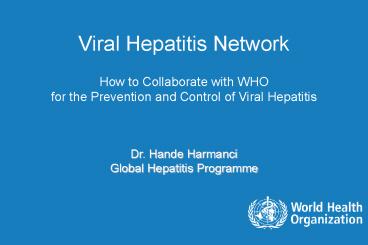Template ppt presentation - PowerPoint PPT Presentation
1 / 21
Title:
Template ppt presentation
Description:
Viral Hepatitis Network How to Collaborate with WHO for the Prevention and Control of Viral Hepatitis Dr. Hande Harmanci Global Hepatitis Programme – PowerPoint PPT presentation
Number of Views:110
Avg rating:3.0/5.0
Title: Template ppt presentation
1
Viral Hepatitis Network
How to Collaborate with WHO for the Prevention
and Control of Viral Hepatitis
Dr. Hande Harmanci Global Hepatitis Programme
2
- In 2010, resolution WHA63.18 call for a
comprehensive approach to the prevention and
control of viral hepatitis. - As a response, the Global Hepatitis Programme is
established in December 2011 with a vision - A world where viral hepatitis transmission is
stopped and all have access to safe and effective
care and treatment - The complexity associated with different types of
hepatitis viruses requires a tight partnership of
all stakeholders
3
Ways of Collaboration
- Viral Hepatitis Network
- WHO Collaborating Centers
4
Viral Hepatitis Network(VHN)
5
Purpose
- To provide a forum for exchange of information
and collaboration among the various stakeholders
in order to implement a common viral hepatitis
work plan
6
Objectives - I
- Raise awareness of the viral hepatitis problem
globally. - Foster partnerships among different groups
relevant to regional and country goals. - Generate country and regional data that
contribute to a better understanding of viral
hepatitis and related interventions.
7
Objectives - II
- Advocate for "research for policy" in viral
hepatitis. - Contribute to the prevention of transmission.
- Strengthen national and regional capacities for
surveillance, prevention and control of viral
hepatitis. - Advocate for equity in access to treatment and
medicines.
8
Members of the VHN
9
The Core Group
- A balanced representation of all WHO regions
- Develops the set of rules for the VHN
- Mandate
- Operational structure
- Membership
- First official meeting will be in the last
quarter of 2012
10
Principles of Collaboration
- Share information voluntarily
- Enhance synergies by avoiding duplication of
efforts - Contribute to fill in knowledge gaps
- All members and collaborators will strive to
- Support the global hepatitis strategy
- Actively participate in VHN meetings and
activities - Actively strive to make the VHN effective and
efficient
11
Establishing a Global WHO Network for Viral
Hepatitis
Meeting Report 16-17 October 2012 Izmir, Turkey
12
Steering Committee membersStructure
13
At this meeting of the Global HepNet, the
following technical working groups were formed
WHO Axis Global HepNet Technical Working Group Members
Raising awareness, promoting partnerships and mobilizing resources Advocacy and Communications Charles Gore
Evidence-based policy and data for action Surveillance Francisco Averhoff, Jorge E. Gonzalez, Belgin Ünal
Molecular Epi Hakan Abacioglu, David H. Muljono, Murat Sayan
Prevention of transmission Vaccination Selim Badur, Fuqiang Cui, Jorge E. Gonzalez, David H. Muljono
Screening, care and treatment Reference laboratories Hakan Abacioglu, Scott Bowden, Vladimir Chulanov, Jorge E. Gonzalez, Richard Tedder
Cross cutting Research Agenda Francisco Averhoff, Belgin Ünal
Hep E Rakesh Aggarwal, Jorge E. Gonzalez, Arzu Sayiner, Richard Tedder
Hep B David H. Muljono, Arzu Sayiner, Ponsiano Ocama
14
WHO Collaboration Centers
15
What are WHO collaborating centers?
- "an institution designated by the
Director-General to form part of an international
collaborative network carrying out activities in
support of the Organization's programme at all
levels. - Today, over 800 collaborating
- centres in over 80 countries
- worldwide.
- http//www.who.int/collaboratingcentres/database/e
n/
16
What do they do?
- The designation as a WHO CC formalizes a
long-standing successful collaborative
relationship between WHO and an external
institution. - The designation is implemented through a
time-limited, contractual agreement of
collaboration under which the designated
institution commits to developing and
implementing a series of collaborative activities
with WHO.
17
Viral Hepatitis related CCs
- US-CDC, Division of Viral Hepatitis
- WHO CC for Reference and Research on Viral
Hepatitis - University of Western Cape (SA)
- WHO CC for Oral Health
- St.Vincent's Institute of Medical Research
- WHO CC for Diagnostics and Laboratory Support for
HIV/AIDS and Other Blood-borne Infections - HPA-UK
- WHO CC for Laboratory and Diagnostics Support
18
8 Key criteria
- High scientific and technical standing nationally
and internationally - Prominent place in the country's health,
scientific or educational structures - High quality of leadership with sufficient number
of qualified staff - Stability in terms of personnel, activity and
funding - Strong working relationship with other
institutions at national, regional and global
level - Clear ability, capacity and readiness to
contribute to WHO programme activities - Technical and geographical relevance of the
institution and its activities to WHO's programme
priorities - At least two (but in most cases many more) years
of previous collaboration with WHO in carrying
out jointly planned activities
19
Incentives for CC
- Enhanced visibility and recognition by national
authorities - Public attention to the health issues they work
on - Improved (international) opportunities to
exchange information and develop technical
cooperation with others - Additional and sometimes important resources
from funding partners
20
Conclusion
- VH is a huge burden on lives and economies of
people - Collaboration of different parties are needed to
prevent and control VH. - As a non-commercial, informal and voluntary
collaboration, the VHN seeks to bring together
representatives from the various sectors!
21
- hepatitis_at_who.int
- Thank you































